The Changes section within the My Tasks Prescription portal is used to manage electronic prescription change requests sent to your practice by the pharmacy via the SureScripts network. These include prescription change requests for generic substitution, prior authorization, therapeutic interchange/substitution, drug use evaluation, script clarification, out of stock and prescriber authorization.
Pharmacy Change Requests
As a practice, you will be able to determine if you receive change requests from the pharmacy or not. This setting must be configured by a member of our support team. Please contact support to have this setup.
Once enabled, change requests initiated by the pharmacy will flow into the Changes queue. Your team will be able to review, triage, and approve, replace, validate or deny the request. Prescribers can expect the following types of change requests from pharmacies:
- Generic Substitution: used to request a prescriber allow the dispensing of a generic medication when substitution is not allowed by prescriber or regulation. Available responses for generic substitution change requests include approve, replace and deny.
- Prior Authorization: used to request a prescriber review the drug requested and obtain a prior authorization from the payer for the existing prescription. Available responses for prior authorization change requests include approve and deny.
- Therapeutic Interchange/Substitution: used to request a prescriber authorize a therapy change to the original prescription. This includes the workflow where a pharmacy requests a 30-90 day quantity or a formulary change. Available responses for generic substitution change requests include approve, replace and deny. Available responses for therapeutic interchange/substitution change requests include approve, replace and deny.
- Drug Use Evaluation: used to request a prescriber authorize a change to the patient's current medication therapy, such as a dosing regimen change or an alternative medication that will have fewer, or no, adverse effects than the original prescription. Available responses for drug use evaluation change requests include approve, replace and deny.
- Script Clarification: used to request a prescriber clarify the original prescription. Available responses for script clarification change requests include approve, replace and deny.
- Out of Stock: used to request a prescriber authorize a change to the original prescription due to the pharmacy being out of stock of the requested medication. Available responses for out of stock change requests include approve, replace and deny.
- Prescriber Authorization Required: used to request prescriber authorization information, such as confirming DEA number or enrollment with prescription benefit plan. Available responses for generic substitution change requests include validate and deny.
Differences from the prescribed medication and the pharmacy requested medication will display highlighted in yellow as shown below.

The pharmacy's change reason will display at the bottom of the change request when sent.
The Changes section within the My Tasks Prescription portal is used to manage electronic prescription change requests sent to your practice by the pharmacy via the Surescripts network. Each user in the practice will be able to determine what changes show in his/her task lists to ensure they only see the appropriate change requests to accommodate his/her workflow. These settings can be modified by following the below steps:
Steps to Configure Assignment Setup
- Navigate to My Tasks > Prescriptions.
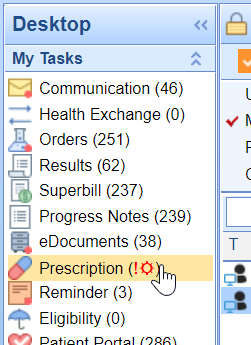
- Open the Changes tab.
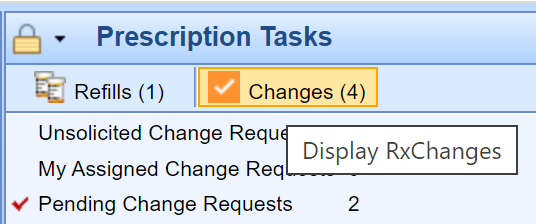
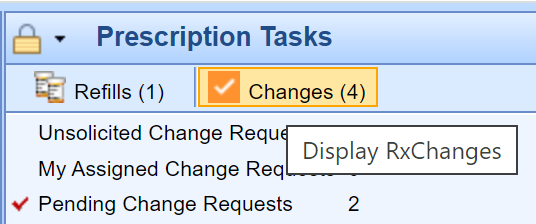
- Click the More dropdown.
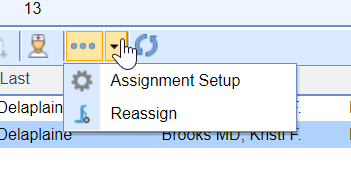
- Select Assignment Setup.
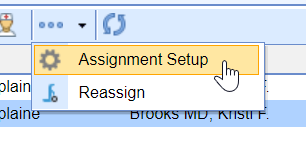
- Modify the settings to meet your needs/workflow.

- Click the Save button.

Assignment Setup Details
The following options can be modified in the Assignment Setup window:
My Task Counts
The My Task Counts section allows a user to determine how the My Task > Prescriptions counts are tallied.
- None - Regardless of change requests assigned to you, no numbers will display in the My Tasks > Prescription queue. This would be appropriate for a user that does not use the changes task list.
- Unsolicited - This will tally up change requests in the Unsolicited Change Requests queue. This would be appropriate for a user that is assigned to triage change requests that can not be automatically assigned to a patient.
- My Assigned - This will tally up change requests in the My Assigned Changes queue. This would be appropriate for a user that reviews and approves change requests that get assigned directly to them or a user group they are in.
- Pending - This will tally up change requests in the Pending Change Requests queue based on requests assigned to prescriber that they are or work for/on behalf of. This would be appropriate for a practice that does not assign change requests to specific users/user groups, rather they are/work on behalf of specific prescribers.
Default Prescribers
This is the list of providers that are set up with Surescripts to electronically send prescriptions and receive change requests. By selecting a prescriber location from this list, you will see change requests assigned to this prescriber location within the Pending Change Requests list that have not been assigned to a specific user/user group. It also configures which prescriber locations to display requests for in the Completed Change Requests queue.
Update Additional Users
Once you have configured a queue for a user, it may be appropriate to configure others in the practice to have the same settings. To do this, supply a list of User ID's for users that need these same settings as you. Separate each user name with a comma.
Users have a variety of options when managing the change tasks queues. These various queues allow for distinct activities to take place in order to efficiently manage the workflow related to these requests. This article will discuss each queue in detail.
Unsolicited Change Requests
Purpose
Unsolicited change requests are requests that have been received but are not yet assigned to be approved or denied. A request will end up in this queue in the event that the request can not be automatically associated with a patient and/or a provider.
Guidance
It is recommended that practices designate one-to-many users to manage the Unsolicited list. This user or group of users would be responsible to associate a valid patient and potentially user to the request.
Configuration
To configure a user to have access to the Unsolicited queue, select the Unsolicited checkbox in the My Task Counts section of the Assignment Setup for Prescription Change Requests screen.
My Assigned Change Requests
Purpose
The My Assigned change requests are requests that have been specifically assigned to your user/user group with the expectation that you will review and manage these requests. Managing a request may mean adding information, assigning the request to other users, approving, replacing, or denying the request
Guidance
It is recommended that users actively monitor and manage items in the My Assigned queue on a daily basis.
Configuration
Be sure that your user has the 'My Assigned' option selected in the Assignment Setup for Prescription Change Requests screen.
Pending Change Requests
Purpose
The Pending change requests are requests that are no longer unsolicited and are waiting to be managed by a user or a group of users. The items found in this list are based on the settings applied in the Assignment Setup screen for your user. Managing a request may mean adding information, assigning the request to other users, approving, replacing, or denying the request
Guidance
It is recommended that users actively monitor and manage items in the Pending queue on a daily basis. Items managed from this list are typically not assigned to your user directly but are associated with a provider that you may work with or on behalf of.
Configuration
Be sure that your user has the 'Pending' option selected in the Assignment Setup for Prescription Change Requests screen. Also, be sure you have selected the correct providers that you work with or on behalf of in the Assignment Setup screen.
Completed Change Requests
Purpose
The Completed change requests are requests that have been approved, replaced, or denied in the last 7 days. The list will display completed requests assigned to you or ones associated with a provider that you work with or on behalf of.
Configuration
Be sure you have selected the correct providers that you work with or on behalf of in the Assignment Setup for Prescription Change Requests screen.
For users that manage the Unsolicited Change queue, one of the key responsibilities is linking change requests to the correct patient in your application. Most of the time, this connection will happen automatically if the correct data points are supplied by the pharmacy that initiated the request. In the event that a patient can not be auto-linked to the change request, you will need to perform the steps below:
Steps to link a patient to an unsolicited change request
- After selecting the change request from the list on the left, you will see a prompt asking you to associate the change to a patient. The patient details provided by the pharmacy will show on the left.
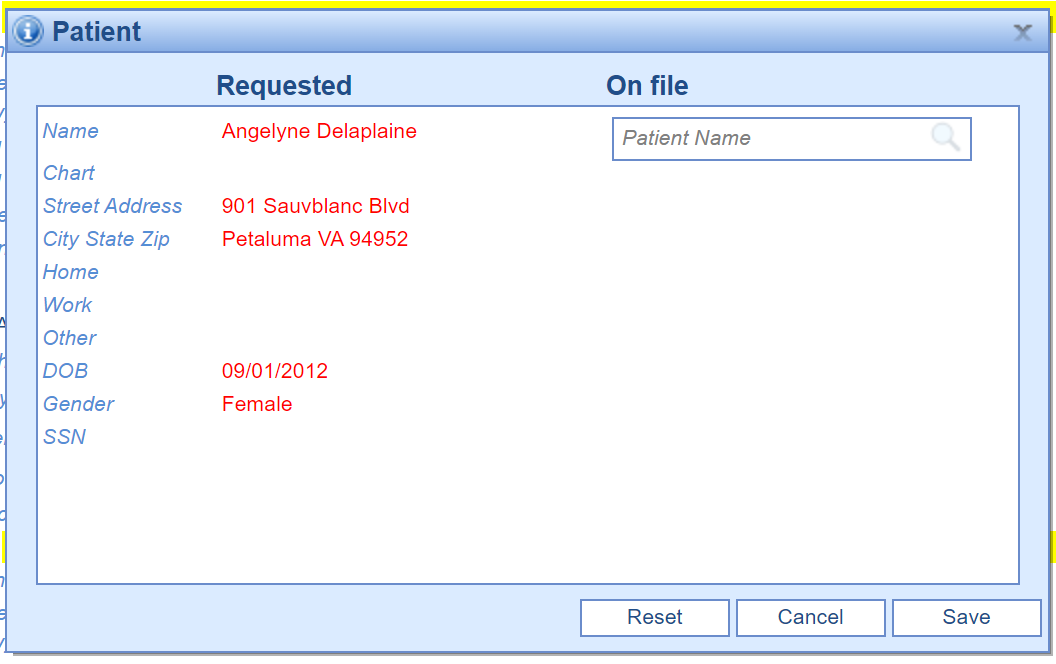
- Use the search box to find the patient you wish to link the request to. Select the patient from the list.
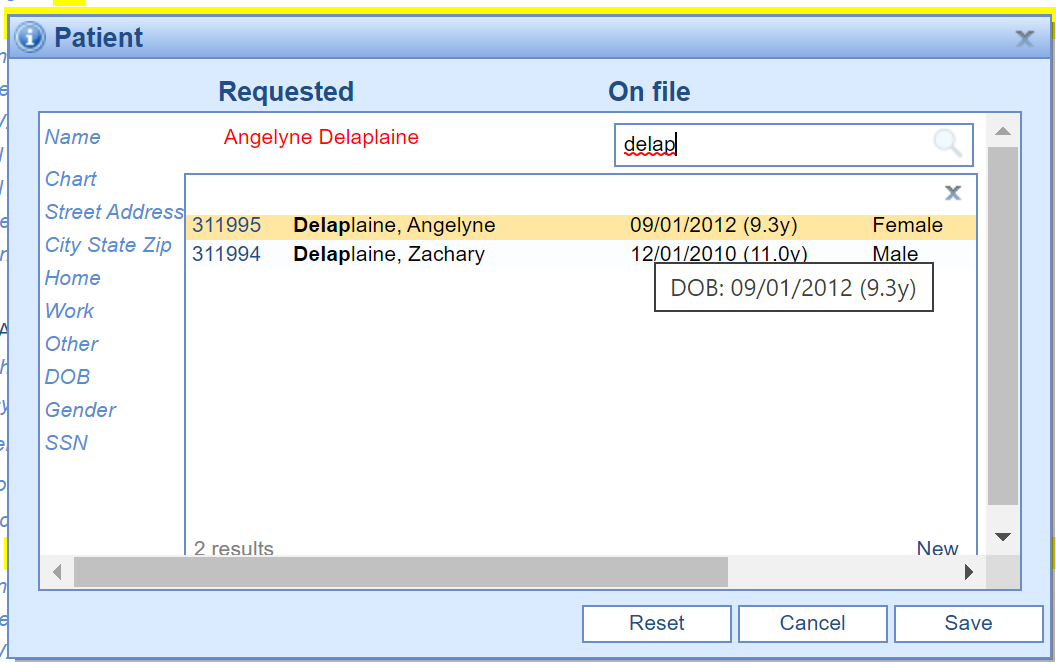
- The system will compare the demographics provided by the pharmacy to the demographics on file in the application. Differences will be shown in red for your convenience.
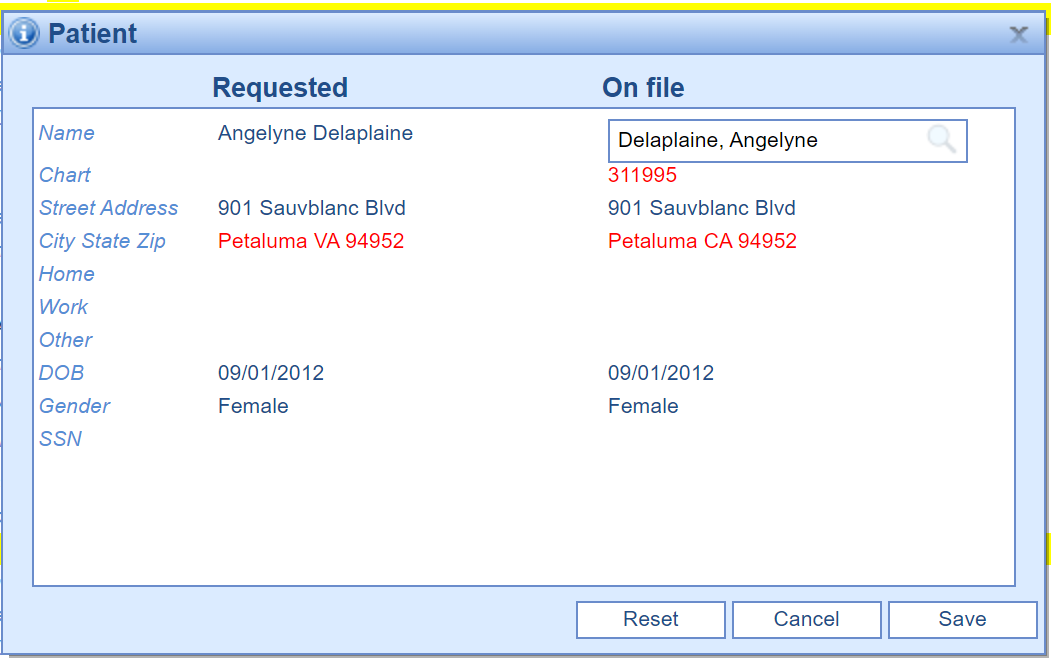
- Click Save to associate the change request to the selected patient. This request will now display in the Pending Change Requests queue.

For users that manage the Prescription Changes task list at any level, you may find it necessary to change the owner of a change request. You may do this because you need more information from a colleague, or you may just be assigning an unsolicited change request to its rightful owner. No matter the reason, use the steps below to change the owner of a change request.
Please note, making this change will put the request into the 'My Assigned' queue for the user/user group you send it to.
Steps to change or remove the owner of a change request
- After selecting the change request from the list on the left, you will see all the details of the request.
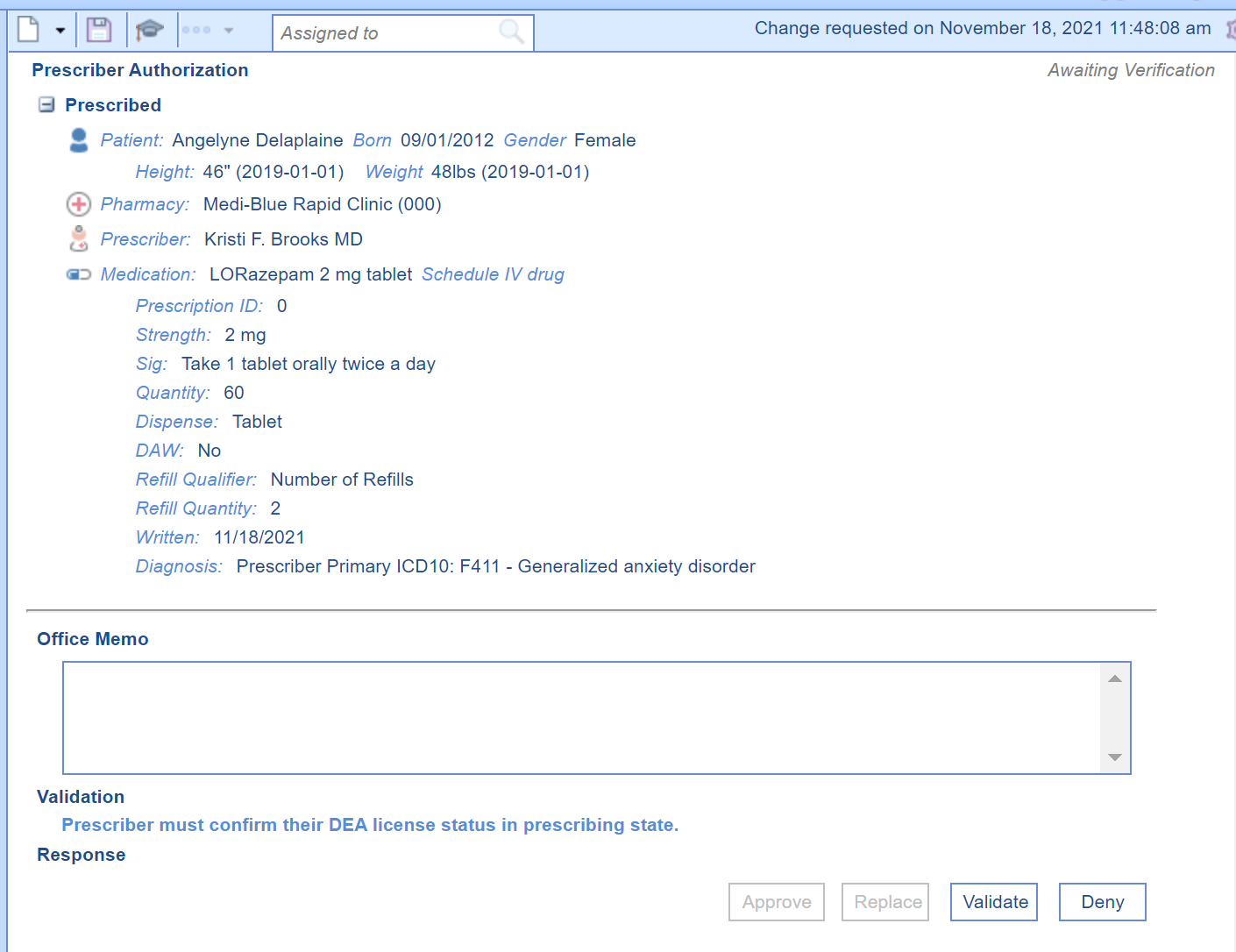
- To change the owner, put your cursor in the search box and begin typing the name of the user you want to assign the request to. Once found, select the user's name. Please note, to remove all owners from the request, click the X to clear out the owner.
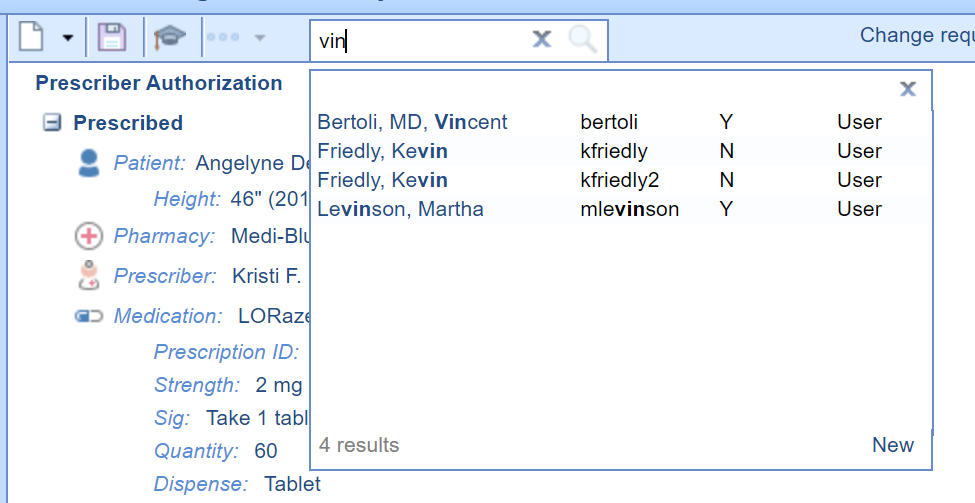
- Click Save.

Success!
This request will now be available in that user's My Assigned queue.
For users that have the ability to respond to a prescription change request, you will need to take action on the requests that are assigned to you. Taking action means completing one of the following for each request: approve, deny, replace, validate or reassign the request.
- Approve the Request: Take this action when you want to approve the change request exactly as it has been requested from the pharmacy. The only change you can make is to add an approval note to the pharmacy.
- Please note, you may not be able to approve a request under the following conditions:
- If the medication is a controlled substance. Controlled substances can only be denied, validated or replaced.
- If the request is missing required information.
- Please note, you may not be able to approve a request under the following conditions:
- Replace the Request: Take this action when you want to change anything about the original request or you wish to "approve" a request for a controlled substance. This could include changing the dosage, instructions, or the medication entirely.
- Validate the Request: Take this action to validate prescriber authorization information, such as confirming DEA number or enrollment with prescription benefit plan.
- Deny the Request: Take this action when you do not want the request to be approved in any way. This may be because the patient is no longer in your care, they stopped taking the medication, or any other reason.
- Please note, you may be required to deny a request under the following conditions:
- if the medication is not a codified medication (i.e. a compound medication), the medication is for a controlled substance and the pharmacy cannot accept controlled substance change responses.
- Please note, you may be required to deny a request under the following conditions:
- Reassign the Request: If you don't feel that you have enough information to respond to the request, you may find it beneficial to type in an "office memo", then change the owner on the request so that another user can gather the information and then re-assign it to you.
Steps to Approve
- After selecting the change request from the list on the left, you will see all the details of the request.
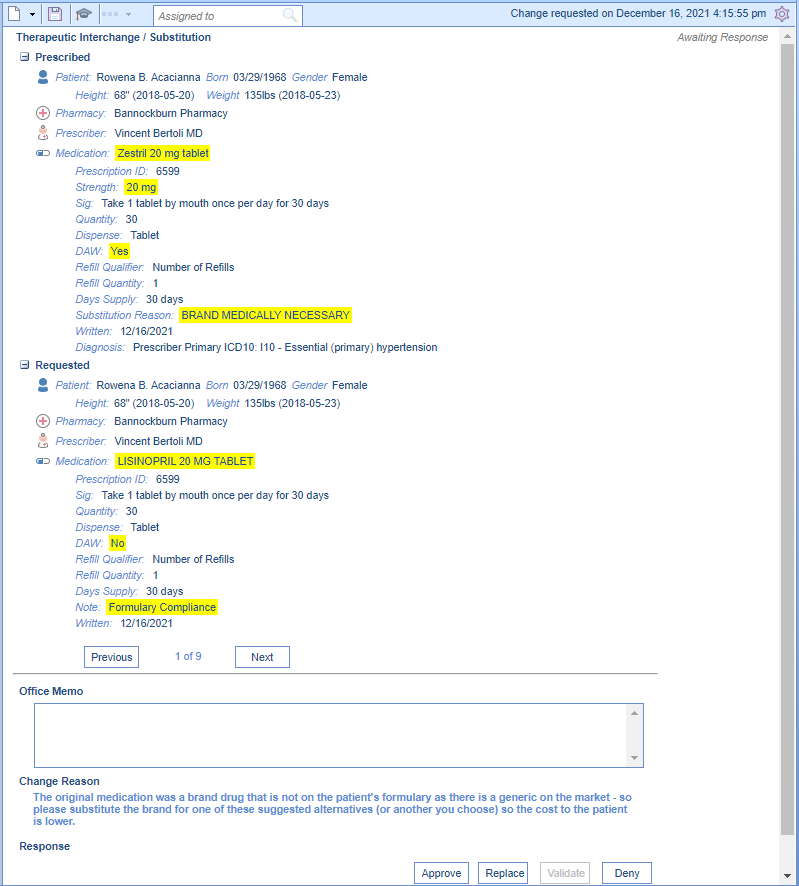
- Click Approve.

- Select the appropriate Fill Statuses you wish to receive. You can optionally decide to add an approval comment to send to the pharmacy.
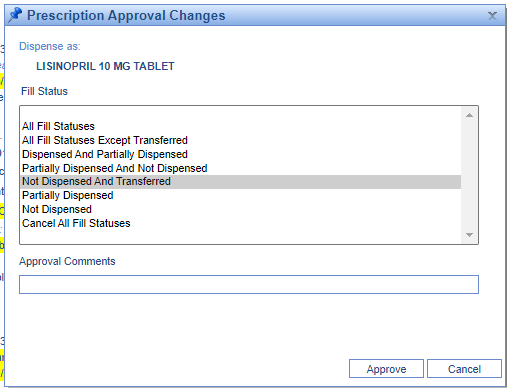
- Click Approve.

Success!
This request will now be moved to the 'Completed Change Request' queue.
Steps to Replace
- After selecting the change request from the list on the left, you will see all the details of the request.
- Click Replace.

- Add an optional comment to the pharmacy and select the Replace button.

- The prescription pad will open. Use this to modify the prescription in any way you see fit other than the prescriber and pharmacy.
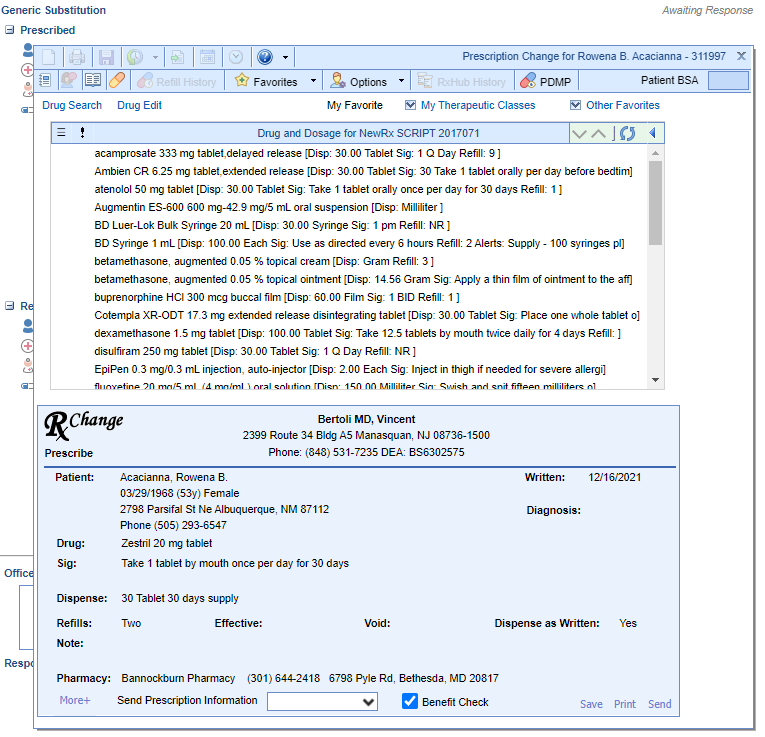
- Click Send on the Rx Pad.

Success!
This request will now be replaced and moved to the 'Completed Change Requests' queue.
Steps to Validate
- After selecting a prescriber authorization change request from the list on the left, you will see all the details of the request.
- Click Validate.
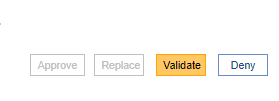
- Supply appropriate authorization information and optional comment to the pharmacy. Click the Validate button.
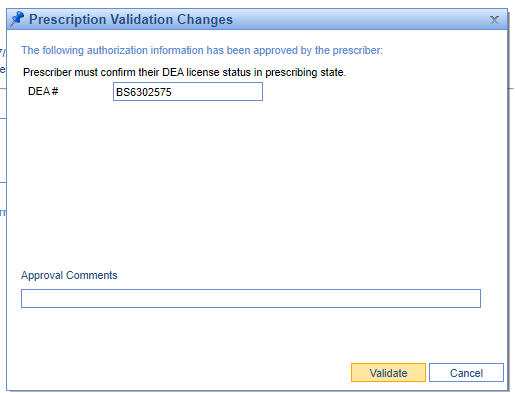
Success!
This request will now be validated and moved to the 'Completed Change Requests' queue.
Steps to Deny
- After selecting the change request from the list on the left, you will see all the details of the request.
- Click Deny.

- Supply a denial reason and/or a denial comment to the pharmacy. Click the Deny button.
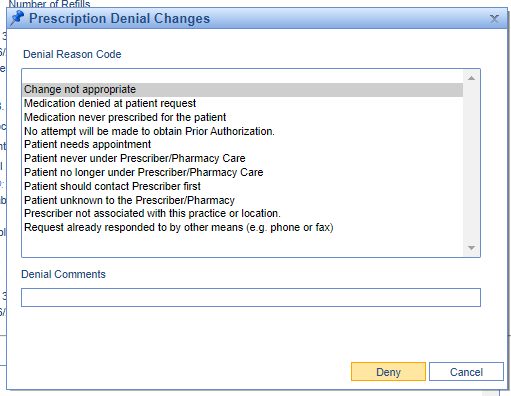
Success!
This request will now be denied and moved to the 'Completed Change Requests' queue.
Prescription Change Requests sent by pharmacies should be replied to within 24-48 hours of receipt. All prescription change requests should be responded to with at least a denial when possible. In the event that a change request is outdated, follows these steps to delete the change request:
- Access the Prescription Change Requests Task list.
- Select the prescription change request you wish to delete in either the Unsolicited, My Assigned or Pending Change Requests queue.
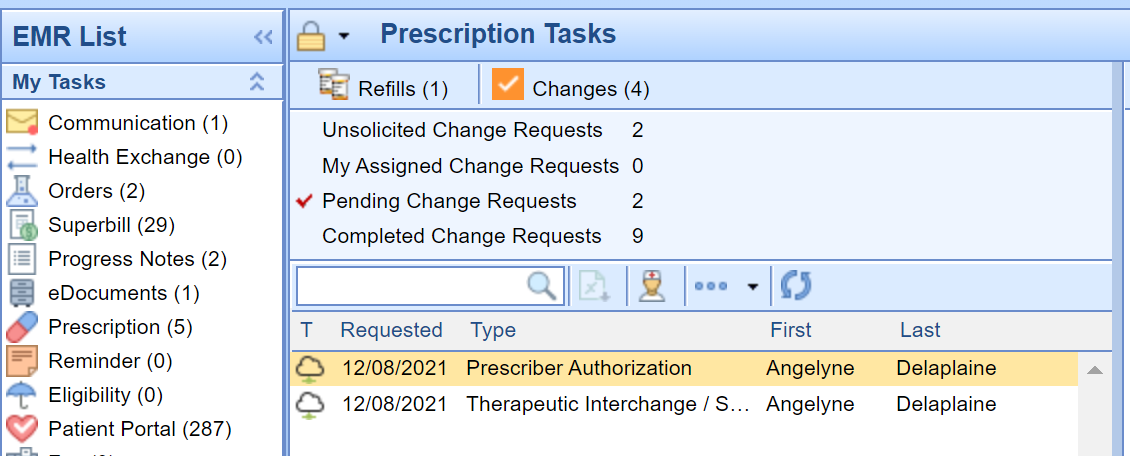
- Click on the New menu.

- Select the Delete menu option.

For practices that utilize the Prescription Change request feature, you may find it necessary to reassign several change requests from one user to another. This may be because an employee is on vacation and you would like someone else to manage their tasks, an employee may have been terminated, or you just need to re-distribute the workload. Regardless of the reason, you can use the Reassign function to mass update several requests all at once.
Steps to Reassign Change Requests
- While in the Prescription Change tasks queue, search for the items you would like to reassign. This is done by first selecting the correct queue, then typing in your desired search (e.g. by Provider name, User/User Group, or patient).
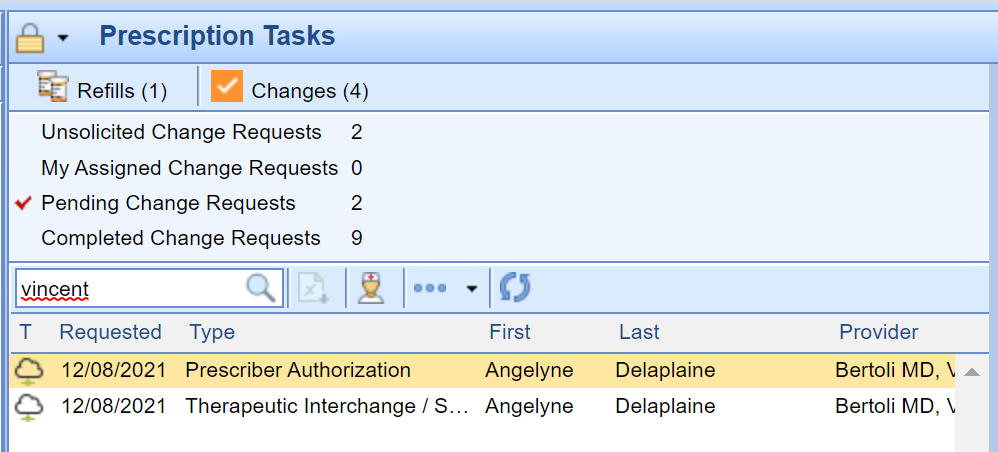
- Once the list returns, click the down arrow on the More menu.
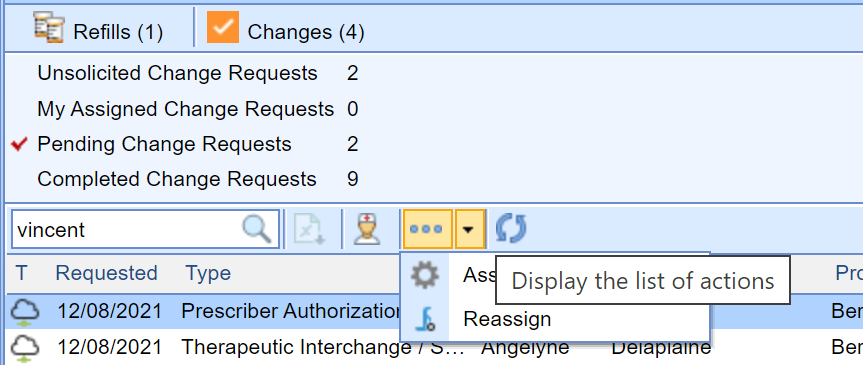
- Select Reassign.
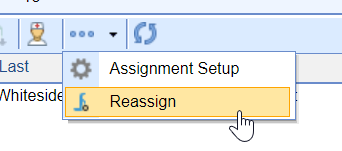
- On the Task Action window, use the Assignment search box to identify the user or user group you would like to assign the requests to. You can optionally add an Office Memo to all of the requests that you are reassigning so that the recipient knows why they have been assigned this task. Alternatively, if you are needing to remove the assignment (rather than change to another user), click the Remove Assignment button.
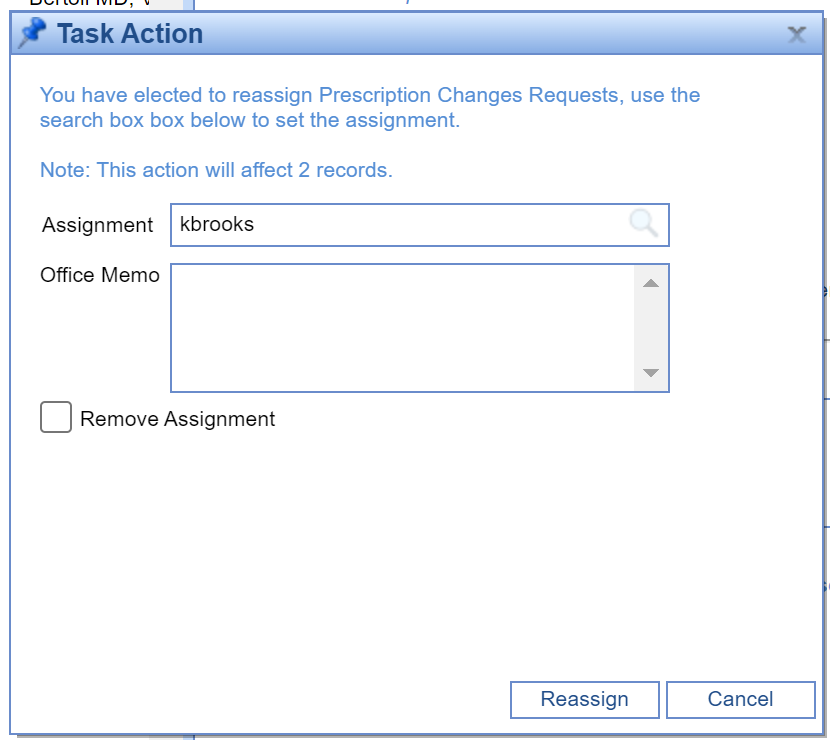
- Click Reassign.

Success!
The requests will now be routed to the user or user group that you assigned them to.


































